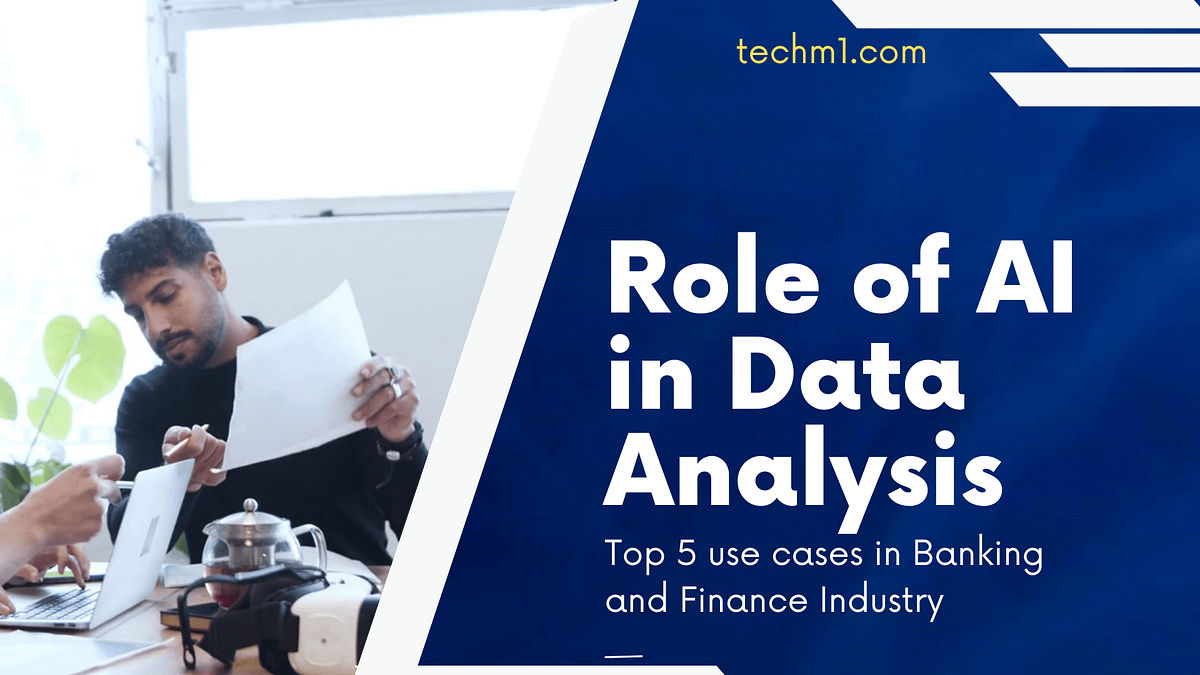
Role of AI in Data Analysis: Top 5 use cases for the Banking and Finance Industry with Examples
In today’s data-driven world, organizations across various sectors are harnessing the power of artificial intelligence (AI) to unlock valuable insights from vast amounts of data. One field that has witnessed a profound impact is the banking and finance industry. AI technologies have revolutionized traditional data analysis approaches, enabling financial institutions to make more accurate decisions, enhance customer experiences, and mitigate risks. This article explores the role of AI in data analysis, highlighting their applications and the transformative impact on the banking and finance sector.
1. Advanced Data Processing and Pattern Recognition by AI
AI algorithms possess the ability to process massive volumes of data quickly and efficiently. This allows banks and financial institutions to analyze diverse data sources, such as customer transaction records, market trends, and economic indicators, in real-time. ML models can identify complex patterns, anomalies, and correlations within the data that would be difficult for human analysts to discern manually.
Example: Credit Risk Assessment AI-powered credit risk assessment models analyze borrower data, transaction history, credit scores, and other relevant information to predict the likelihood of default. By identifying patterns and assessing risk factors, these models assist banks in making informed lending decisions, reducing the chances of bad loans.
2. Personalized Customer Experiences
AI enables banks to deliver personalized services and experiences to their customers. By analyzing customer behavior, preferences, and historical data, algorithms can provide tailored recommendations, product offerings, and targeted marketing campaigns. This level of personalization enhances customer satisfaction and loyalty.
Example: Chatbots and Virtual Assistants Banks employ AI-powered chatbots and virtual assistants to provide instant and personalized customer support. These intelligent systems can handle routine inquiries, process transactions, and offer personalized financial advice, thereby improving customer engagement and reducing operational costs.
Fraud Detection and Prevention
3. Fraud Detection and Prevention
The banking and finance industry faces ever-evolving threats from fraudsters. AI technologies play a critical role in combating fraud by continuously monitoring transactions, identifying suspicious patterns, and detecting fraudulent activities in real-time. ML algorithms can adapt and learn from new fraud patterns, improving detection accuracy over time.
Example: Anomaly Detection ML algorithms analyze transaction data, customer behavior, and historical patterns to identify anomalies that may indicate fraudulent activity. Unusual spending patterns, geographical inconsistencies, or suspicious transactions can trigger alerts, enabling banks to take immediate action to prevent financial losses and protect customers’ assets.
Portfolio Management and Trading
4. Portfolio Management and Trading
AI empowers financial institutions to optimize portfolio management and trading strategies. These technologies can analyze historical market data, news sentiment, and macroeconomic indicators to identify investment opportunities, optimize asset allocation, and automate trading processes.
Example: Algorithmic Trading AI-powered trading systems employ ML algorithms to analyze market data and execute trades based on predefined strategies. These systems can process large volumes of data in real-time, enabling rapid and accurate decision-making. Algorithmic trading has the potential to increase trading efficiency, reduce transaction costs, and improve investment returns.
Risk Assessment and Regulatory Compliance
5. Risk Assessment and Regulatory Compliance
AI have transformed risk assessment and regulatory compliance in the banking and finance industry. These technologies can analyze large amounts of data to identify potential risks, monitor compliance with regulations, and detect suspicious activities.
Example: Anti-Money Laundering (AML) ML algorithms can analyze vast datasets to identify unusual transaction patterns that may indicate money laundering or other illicit activities. By automating AML processes, banks can reduce false positives, enhance detection accuracy, and comply with regulatory requirements more effectively.
In summary, artificial intelligence has become indispensable tools in data analysis within the banking and finance industry. By leveraging advanced algorithms, financial institutions can process vast amounts of data, gain deeper insights, and make more informed decisions. The transformative impact of AI is evident in areas such as risk assessment, fraud detection, personalized customer experiences, portfolio management, and regulatory compliance. As these technologies continue to evolve, their role in data analysis will become even more vital, driving innovation and shaping the future of the banking and finance industry.
